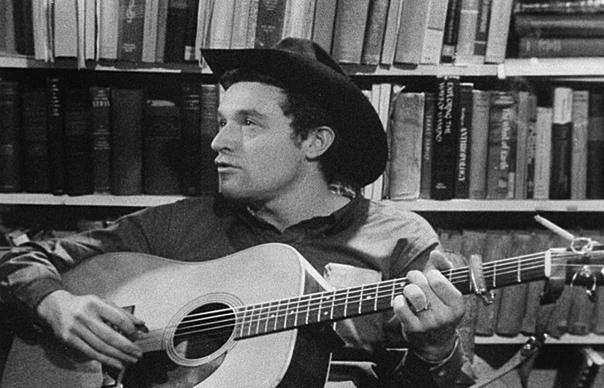Unearthed time capsule from Greenwich Village 1961. Dylan's attendance disputed... For such a fabled hotbed there’s precious little footage of New York’s vibrant folk scene at the dawn of the 1960s, a world glimpsed mainly through photographs and memoirs like Dylan’s Chronicles. Give thanks, then, that mover and shaker Alan Lomax threw a jam session at his West Fourth Street apartment, and filmed it in the hope that the BBC would commission a series on the folk revival. The occasion for his semi-impromptu hootenanny was a series of concerts featuring Appalachian musicians Roscoe Holcomb, Clarence Ashley and Doc Watson, but Lomax also arranged for blues giants Memphis Slim and Willie Dixon to join the party, along with Village scenesters like Ramblin’ Jack Elliott, the Greenbriar Boys and the New Lost City Ramblers. Crammed into Lomax’s apartment, swapping tunes and talking to Lomax, they make one fascinating crowd. The Village regulars are an earnest but affable bunch, hanging on every chord of the older Kentucky singers. A deadpan Holcomb obliges with a rivetting “I Wish I Was A Single Girl Again” delivered in his keening ‘high lonesome’ voice, while Doc Watson unfurls some mesmering picking and Clarence Ashley dwells on the nature of the much sung-about “Coo Coo Bird”. Of the locals Rambling Jack, Woody Guthrie’s understudy, impresses with sheer chutzpah, a Jewish cowboy singing “Cocaine”. Strangest is Peter LaFarge, with his cod theatrical delivery, a handsome but troubled soul who would commit suicide a few years later. Across the room Carla Rotolo, sister of Bob Dylan’s girlfriend, gazes on intensely. You half expect Bobby himself to breeze through the door, but despite the testimony of cameraman George Pickow, who in the accompanying documentary claims Dylan was “sat in the corner smoking pot and avoiding the camera”, Little Hibbing’s finest had barely arrived in town, a point made by Lost City Rambler John Simon, whose exposition of the event is illuminating and moving. The music of Willie Dixon and Memphis Slim makes an odd fit with the bluegrass and folk– these were architects of Chicago’s gritty electric R&B – but Lomax saw American music as a broad church, and Willie and Slim had no problem devising an acoustic set for folk crowds on both sides of the Atlantic. Here, Dixon, a bear of a man, plucks double bass while Memphis Slim plays hell out of a battered harmonium huffed up by vacuum cleaner. Lomax himself proves an unexpectedly pugnacious presence, a reminder that he was an impresario and civil rights activist as well as “the man who recorded the world”. His vision in making this rough but charming snapshot, proved prescient. Neil Spencer
Unearthed time capsule from Greenwich Village 1961. Dylan’s attendance disputed…
For such a fabled hotbed there’s precious little footage of New York’s vibrant folk scene at the dawn of the 1960s, a world glimpsed mainly through photographs and memoirs like Dylan’s Chronicles. Give thanks, then, that mover and shaker Alan Lomax threw a jam session at his West Fourth Street apartment, and filmed it in the hope that the BBC would commission a series on the folk revival. The occasion for his semi-impromptu hootenanny was a series of concerts featuring Appalachian musicians Roscoe Holcomb, Clarence Ashley and Doc Watson, but Lomax also arranged for blues giants Memphis Slim and Willie Dixon to join the party, along with Village scenesters like Ramblin’ Jack Elliott, the Greenbriar Boys and the New Lost City Ramblers.
Crammed into Lomax’s apartment, swapping tunes and talking to Lomax, they make one fascinating crowd. The Village regulars are an earnest but affable bunch, hanging on every chord of the older Kentucky singers. A deadpan Holcomb obliges with a rivetting “I Wish I Was A Single Girl Again” delivered in his keening ‘high lonesome’ voice, while Doc Watson unfurls some mesmering picking and Clarence Ashley dwells on the nature of the much sung-about “Coo Coo Bird”.
Of the locals Rambling Jack, Woody Guthrie’s understudy, impresses with sheer chutzpah, a Jewish cowboy singing “Cocaine”. Strangest is Peter LaFarge, with his cod theatrical delivery, a handsome but troubled soul who would commit suicide a few years later. Across the room Carla Rotolo, sister of Bob Dylan’s girlfriend, gazes on intensely. You half expect Bobby himself to breeze through the door, but despite the testimony of cameraman George Pickow, who in the accompanying documentary claims Dylan was “sat in the corner smoking pot and avoiding the camera”, Little Hibbing’s finest had barely arrived in town, a point made by Lost City Rambler John Simon, whose exposition of the event is illuminating and moving.
The music of Willie Dixon and Memphis Slim makes an odd fit with the bluegrass and folk– these were architects of Chicago’s gritty electric R&B – but Lomax saw American music as a broad church, and Willie and Slim had no problem devising an acoustic set for folk crowds on both sides of the Atlantic. Here, Dixon, a bear of a man, plucks double bass while Memphis Slim plays hell out of a battered harmonium huffed up by vacuum cleaner.
Lomax himself proves an unexpectedly pugnacious presence, a reminder that he was an impresario and civil rights activist as well as “the man who recorded the world”. His vision in making this rough but charming snapshot, proved prescient.
Neil Spencer


